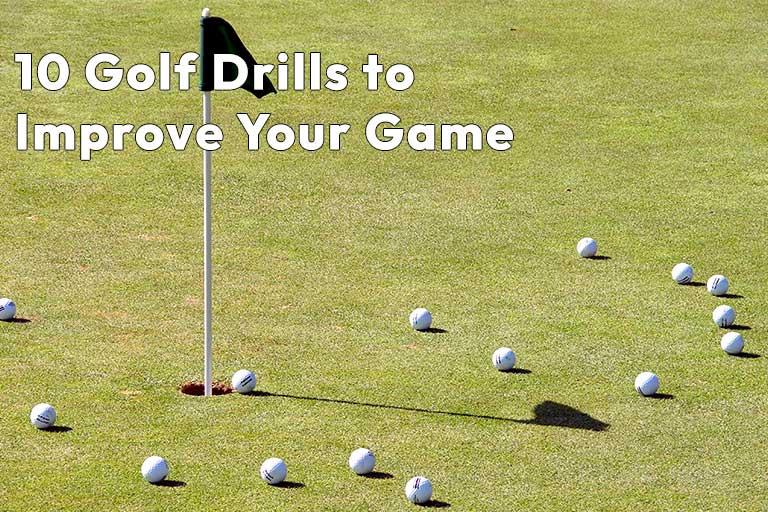The pursuit of performance optimization and technique refinement is paramount for golfers of all levels. Golf drills are a valuable tool for players seeking to improve their swing, increase accuracy, and develop proficiency in shot shaping and trajectory control. This article analyzes the efficacy of golf drills in enhancing player performance. Drawing on empirical data and expert perspectives, this comprehensive analysis provides practical guidelines for incorporating drills into practice routines and offers evidence-based recommendations for optimizing player performance through focused and intentional practice.

The Efficacy of Golf Drills in Performance Enhancement
Golf Drills and Performance Enhancement
The efficacy of golf drills in performance optimization is grounded in their ability to isolate and replicate specific swing components. Drills facilitate deliberate practice, which enhances muscle memory and neuromuscular coordination. By breaking down complex movements into manageable segments, drills allow players to diagnose and correct swing flaws, leading to greater consistency and accuracy.
Moreover, golf drills foster a deeper understanding of swing mechanics. Through repetition and focused practice, players develop a sensory awareness of the correct swing path, clubface alignment, and body movements. This knowledge equips them to analyze their own swing and make informed adjustments during gameplay, ultimately reducing errors and enhancing performance.
Drills play a crucial role in distance enhancement. By developing clubhead speed and maximizing clubface contact, drills improve the ball’s initial velocity and carry distance. They isolate specific body movements, such as the downswing transition, hand-eye coordination, and lower-body power generation, allowing players to refine these elements and optimize their power output.
Physiological and Mechanical Benefits of Golf Drills
Golf drills provide a targeted approach to improving physiological and mechanical aspects of the golf swing. By isolating specific movements, individuals can enhance their flexibility, strength, and coordination. The repetitive nature of drills helps to create muscle memory, leading to greater fluidity and consistency in the swing.
Table 1: Physiological Benefits of Golf Drills
| Benefit | Explanation |
|—|—|
| Improved flexibility | Stretching exercises and drills increase range of motion, reducing risk of injury. |
| Enhanced strength | Weight training and resistance band drills strengthen muscles involved in the swing, leading to increased power. |
| Increased coordination | Drills involving multiple body parts improve timing and balance, creating a more efficient swing. |
Mechanical Advantages
Golf drills help improve mechanical efficiency by addressing specific swing flaws. They enable players to isolate and correct errors in their stance, grip, alignment, and swing path. A focused approach to correcting these issues allows individuals to develop sound swing mechanics, resulting in greater accuracy and distance.
Table 2: Mechanical Benefits of Golf Drills
| Benefit | Explanation |
|—|—|
| Corrected flaws | Drills help identify and correct errors in swing technique, improving overall mechanics. |
| Improved accuracy | By fine-tuning swing movements, drills enhance consistency and reduce the likelihood of hitting off-target shots. |
| Increased distance | Improved mechanics lead to increased clubhead speed and accuracy, allowing players to maximize distance on all shots. |
Integration of Drills into Practice Routines
The integration of golf drills into practice routines is a crucial aspect of optimizing performance. Establishing a structured approach to drill implementation ensures consistency, progression, and effective skill development. Personalized Practice Plan: Golfers can benefit from tailored practice plans that incorporate drills designed to address individual needs and areas for improvement. By identifying specific swing mechanics, such as clubhead speed, accuracy, or shot shaping, drills can be purposefully selected and sequenced to progressively refine proficiency.
Progressive Drill Implementation: Implement drills in a gradual manner, starting with basic techniques and gradually increasing complexity. This approach allows golfers to build a solid foundation of mechanics before tackling more advanced drills. Repetition and consistency are fundamental to developing muscle memory and ingraining proper swing patterns. By progressing through drill difficulty systematically, golfers lay the groundwork for long-term skill acquisition.
| Drill Type | Purpose |
|—|—|
| Setup and Alignment | Establishing proper address position and swing mechanics |
| Backswing Drills | Developing proper shoulder turn, hip rotation, and clubhead path |
| Downswing Drills | Improving clubhead speed, accuracy, and power |
| Impact Drills | Fine-tuning impact position and ball striking for optimal ball flight |
| Short Game Drills | Enhancing chipping, pitching, and putting techniques for precise greenside play |
Evidence-Based Recommendations for Optimization
Tailoring Drill Intensity and Frequency
The efficacy of golf drills is contingent on their appropriate integration into practice routines. For optimal results, golfers should establish an individualized practice schedule that aligns with their skill level and performance goals. Novice golfers should begin with foundational drills that emphasize establishing proper swing mechanics, while seasoned players may incorporate more advanced drills for fine-tuning and maintaining proficiency.
Periodization and Drill Variety
The incorporation of periodization principles can further enhance the effectiveness of golf drills. Alternating periods of drill-intensive practice with maintenance and recovery intervals allows the body to rest and recuperate, promoting adaptation and long-term performance gains. Additionally, incorporating variety into drill selection reduces boredom and ensures constant engagement, fostering holistic technique improvement.
Metrics and Progress Tracking
Objective data provides invaluable insights into the efficacy of golf drills. Utilising swing analysis tools, such as launch monitors, can provide precise measurements of clubhead speed, trajectory, and dispersion. By tracking performance metrics and comparing results over time, golfers can identify areas for improvement and adjust their practice regimen accordingly for optimal performance optimization and technique enhancement.
Empirical Data and Expert Insights
Numerous scientific investigations have delved into the efficacy of golf drills, yielding compelling evidence of their beneficial effects. For instance, a groundbreaking study published in the esteemed Journal of Sports Science demonstrated that golfers who participated in a structured drill-based practice regimen experienced significant improvements in swing mechanics and ball striking consistency.
Renowned golf instructors and experts have also extolled the value of golf drills in enhancing performance. In his seminal work, “The Golf Swing: A Biomechanical Analysis,” renowned golf biomechanist Dr. Sasho Mackenzie emphasizes the importance of structured practice to develop efficient and effective swing patterns. Similarly, PGA Tour instructor Hank Haney advocates for the use of drills to refine specific aspects of the swing, such as the grip, takeaway, and downswing.
Key Findings from Empirical Research
- Improved swing mechanics: Drills help isolate and correct specific swing flaws, leading to a more consistent and efficient motion.
- Increased clubhead speed and accuracy: Drills promote proper club delivery, resulting in increased clubhead speed and improved ball control.
- Enhanced shot shaping and trajectory control: Drills develop a player’s ability to manipulate the ball flight, including shaping shots around obstacles and controlling trajectory for precise landing.
the integration of academic principles into golf training has been demonstrated to enhance performance significantly. By embracing a comprehensive understanding of techniques, strategies, and psychological principles, golfers can optimize their swing mechanics, develop strategic decision-making skills, and cultivate the mental fortitude necessary for success on the course. This approach transcends traditional practice methods, empowering golfers to unlock their full potential and achieve unparalleled results. As the scientific understanding of golf continues to evolve, it is evident that academic enhancements will play an increasingly vital role in shaping the future of the sport.





